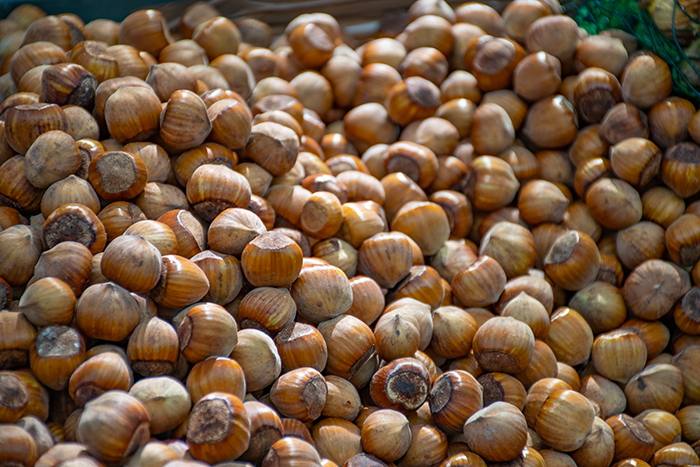
As of this writing, I can officially check the Pacific Northwest off my list of regions to visit. Even though I was in Oregon to visit grass seed farms during the thick of their harvest season, I was intrigued by a totally different crop with a major presence in the area that took me down a rather forage-unrelated rabbit hole: the hazelnut.
Driving along State Highway 99 through the heart of the Willamette Valley, I was surrounded by endless rows of bushy, mid-sized trees. I later learned these were hazelnut orchards when one of the grass seed farmers I met informed me that some of them belonged to her family. At first, I wasn’t interested in hazelnut production — partly because I personally don’t like hazelnuts, and partly because I was there to talk about grass seed. But then the topic kept coming up throughout the week.
In addition to being the official state nut, hazelnut trees occupy over 90,000 acres in Oregon, which are almost all exclusively located in the Willamette Valley. The soil and climate there are nearly perfect for hazelnut farming, and many new orchards have recently been established in the valley because of an uptick in consumer demand. Virtually all of our nation’s hazelnuts come from Oregon, although Turkey is the world leader in production, accounting for about 70% of global supply.
One defining feature of a hazelnut orchard is its incredibly smooth orchard floor. Upon first glance, I was dismayed by the seemingly parched and severely compacted soil surface beneath the trees until I learned that orchard floors must be regularly dragged and diligently maintained to provide a pristine landscape for harvest activities.
Hazelnuts drop when they ripen, littering the ground below the trees, and then farmers gather the nuts into windrows with blowers and sweepers. Therefore, a smooth orchard floor prevents hazelnuts from falling into ruts or depressions in the soil, and it reduces the amount of debris that gets mixed up with the harvest. At this point, farmers make another pass over the windrows with collectors to pick up the nuts and sort out sticks and leaves. Then, hazelnuts are processed, undergoing several steps, including dehusking, cleaning, sizing, and cracking before being roasted, steamed, or coated in an endless combination of spices and seasonings.
According to Oregon State University Extension, a mature orchard can produce anywhere from 2,000 to 4,000 pounds of hazelnuts per acre, and if managed well, orchards can be productive for 40 to 50 years.
Upon some more research, I learned that hazelnuts and their healing properties have been celebrated for hundreds of years. First-century physicians mixed ground hazelnuts with honey or black pepper to cure chronic coughing and common colds. Ancient Chinese manuscripts claimed hazelnuts were one of the five sacred foods bestowed upon humans from the heavens above. And apparently, if one experienced a receding hairline or normal baldness during the Roman Empire, smearing mashed hazelnut shells on their head was recommended to encourage new hair growth.
I also learned hazelnuts are called filberts, which is an acceptable name for both the nut and the tree, and quite frankly, “filbert” is more fun to say.
In the midst of my filbert frenzy, I stopped at souvenir shops and convenience stores to buy bags of dry roasted, chocolate-covered, and butter pecan-flavored hazelnuts to bring back to my family and friends. I got some for myself, too. And on my way to the airport to catch my flight home, I poured myself a cup of coffee in the hotel lobby, adding a generous serving of the hazelnut creamer that was provided on the counter.
To be honest, I still don’t like hazelnuts. But after developing a newfound appreciation for the crop and the farmers who grow it, snacking on filberts and drinking hazelnut-flavored coffee was my way of paying homage to the industry. It also just felt like the right thing to do while visiting the hazelnut capital of the country.
All hazelnut humor aside, a similar sentiment can ring true for other avenues of agriculture that we may find ourselves venturing along. We don’t have to grow the same crops, we don’t have to raise the same livestock — we don’t even have to consume the end-products. But exploring different production systems and expanding our perspectives on the various resources that provide us with feed, food, fuel, and fiber is a worthy endeavor that offers a lifetime of learning and revolving fund of curiosity.

